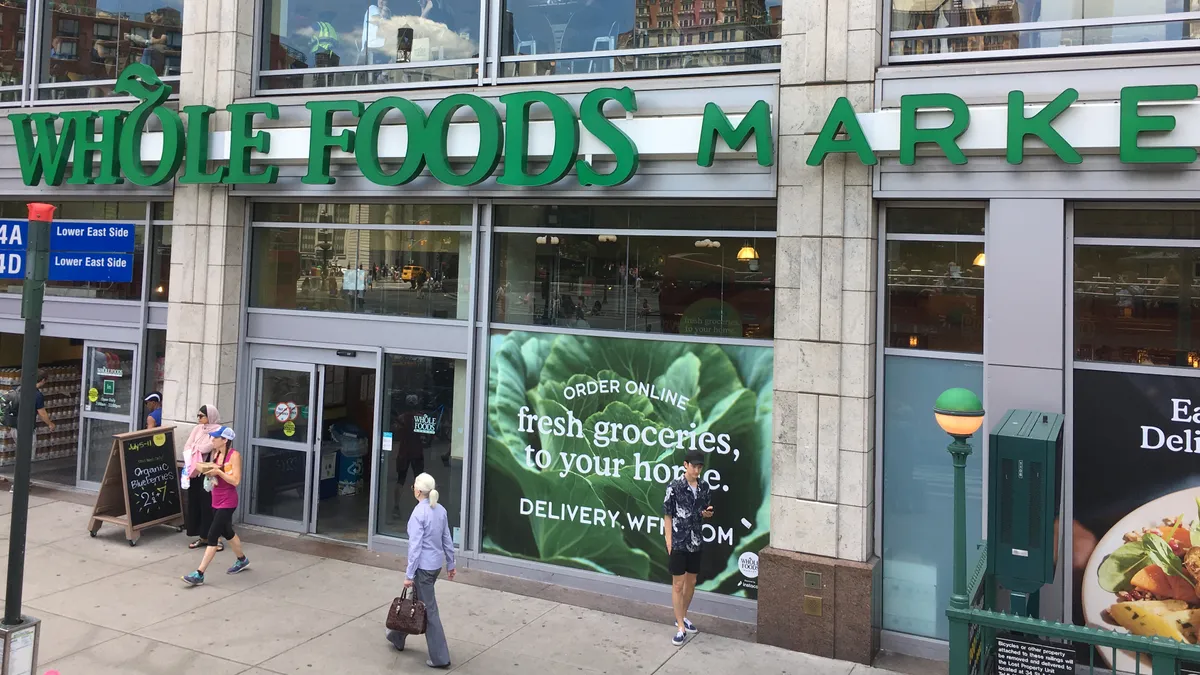Dive Brief:
- Whole Foods poached regular shoppers from several leading retailers during its opening-week price reductions under new owner Amazon beginning in late August, according to shopper tracking firm Thasos Group. Twenty-four percent of the new shoppers that visited the natural and organic retailer were Walmart shoppers, while 10% of Trader Joe’s customers visited Whole Foods during this time period.
- Despite drawing shoppers from value-oriented chains, Whole Foods mainly drew those chains’ more affluent shoppers. The grocer didn’t attract a lower income demographic overall, and didn’t convince shoppers to make longer-than-normal driving trips to stores.
- Defection rates among all competing stores remained higher than normal through the middle of September, the firm found.
Dive Insight:
Thasos Group’s data shows a 17% bump in customer traffic during Amazon’s first week at the helm of Whole Foods. This number tracks with another recent survey, but what’s unique about this new data is that it segmented customers based on where they regularly shop, giving what amounts to a first look, in many ways, at which retailers could be most vulnerable to Amazon’s grocery incursion.
So what are the takeaways? Amazon’s price reductions succeeded in drawing shoppers away from key competitors, including Walmart, Trader Joe’s, Kroger and Sprouts Farmers Market. According to Thasos’ data, 16% of first-time shoppers listed Kroger as a preferred supermarket. Eight percent of Sprouts shoppers visited the store on that first week.
While the percentage of Trader Joe’s and Sprouts customers visiting Whole Foods seems high, it’s important to note that these chains already share a large percentage of shoppers with Whole Foods. More than ever these days, consumers are visiting multiple locations to fulfill their shopping needs.
Most telling, it seems, are those new shoppers to Whole Foods. Although Walmart had the highest percentage here, the mega retailer serves what’s essentially a different customer base than Whole Foods. Kroger, on the other hand, serves a higher income shopper that could defect to Whole Foods as prices keep coming down and promotions intensify. Although Kroger has become very price competitive and offers a wide assortment of specialty products — including its Simple Truth private label line — it may have a difficult time battling the “wow” factor that Amazon can bring to Whole Foods. Investors seem to agree, with the grocer's stock tumbling 40% this year.
Further supporting this conclusion is another key finding from the Thasos data: Despite drawing from a wide range of retailers, Amazon/Whole Foods didn’t bring in lower income shoppers than the grocer typically serves. This flies in the face of Amazon’s assertion that it will make “organic food affordable for everyone.” At the same time, it’s still very early, with Amazon promising more price drops and promotions in the coming months.
Research has shown that Amazon’s opening price cuts at Whole Foods were more about marketing than about actually lowering the chain’s prices. So it’s no wonder the company didn’t move the dial on its demographic appeal. No doubt the e-tailer will work hard to change Whole Foods’ price perception, but it’s ability to reach deep and appeal to value-focused Walmart shoppers, at least for now, remains in doubt.








